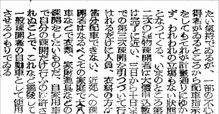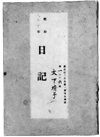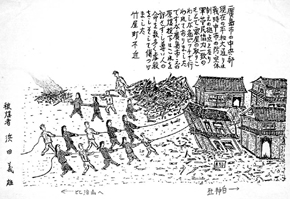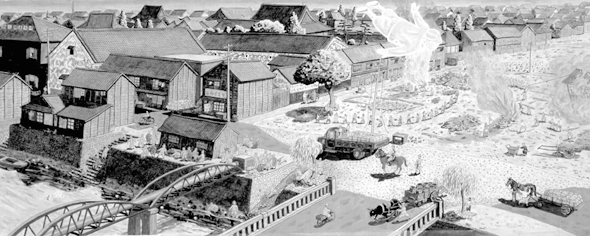 |
| Building Demolition Amplified the Tragedy |
| Building demolition at this time meant taking down buildings to create a fire lane to prevent the spreading of fires in the event of an air raid. On August 6, 1945, thousands of students were sent out for a large-scale building demolition project designed to clear a fire lane dividing the city north and south where Peace Boulevard is today. Because the students in the upper level of national schools and first- and second-year students in secondary school were helping to pull down buildings-outdoors and in the city center-the atomic bomb carried them off in vast numbers. On August 6, approximately 26,800 students were mobilized from schools in Hiroshima City, and 7,200 fell victim to the atomic bomb. Of these 82% were working on building demolition. |
 |
|
|||||||||||||||||||||||||
|
17/Firefighting practice for air raids About 1940 Courtesy of Michiru Tanaka The Air Defense Law passed in 1937 created air defense organizations for every neighborhood, factory, and government agency. Special evacuations, bucket brigades, and other firefighting drills became routine. Also in preparation for air raids, buildings in certain areas were demolished. |
18/Building Demolition in Hiroshima City
|
|||||||||||||||||||||||||

|
 |
|
19/Newspaper article revealing confusion caused by building demolition April 4, 1945 Chugoku Shimbun Courtesy of Chugoku Shimbunsha Forced building demolitions went badly. For the residents in targeted areas, demolition meant losing their beloved homes. Furthermore, too few vehicles and workers were provided to move belongings and clear away several houses at a time. Thus, the projects led to great turmoil. |

|
|

|
Sunday, June 3 Weather: sunny Today we had to clean the roads, even though it was Sunday. We carried off roof tiles and pieces of wood to clear off the roadway. I borrowed a shovel from someone and shoveled sand into a rope basket. While I was digging, the shovel hit a big brick. It took Nishio-san, Yamada-san and me working together to wrestle that brick out. |
 21/Building demolition About 1945 Near Takeya-cho (Fujimi-cho) Drawing by Yoshio Hamada After removing the shoji paper doors and roof tiles, soldiers and Volunteer Corps would saw through the first-floor pillars. Then they would attach a rope to the beam under the roof and pull the building over. |
|
20/Diary of Nobuko Oshita of first-year students at First Hiroshima Prefectural Girl's High School Courtesy of Yoko Fukumori |
||
 |
| 22/Students cleaning up a site where a house was torn down
Drawing by Shigeo Nishimura Source: Hiroshima-A Tragedy Never to Be Repeated, Fukuinkan Shoten Publishers After houses were pulled over, it was the mobilized students' job to clean them up. Here they are transporting roof tiles by passing them down the line. |
| Mobilized Students -The Lost Tomorrows of the Students- Introduction Schools Stained the Color of War The Start of Student Mobilization Building Demolition Amplified the Tragedy The Suffering of Mobilized Students Looking for Children Reopening in the Burnt Ruins Monuments to the Students Return to TOP |